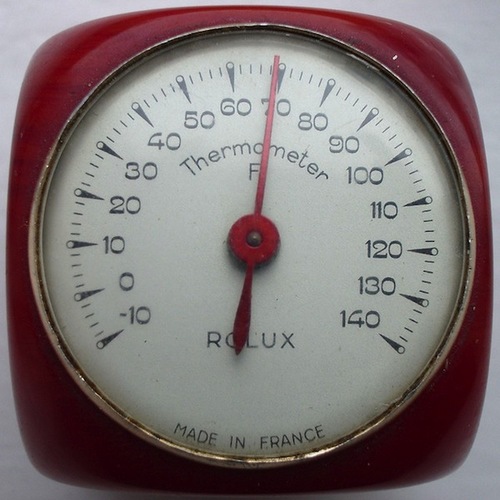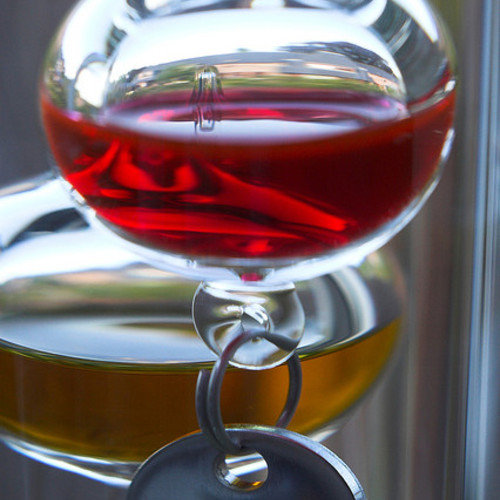
People new to building science and HVAC are confronted with a lot of terms for things that are related but different. Load and capacity. Energy recovery ventilator (ERV) and heat recovery ventilator (HRV). Hot-water heater and cold-water heater. Another pair of terms describes how the local climate impacts the heating and cooling needs of a house. They’re both useful but they give us different information.
Design temperatures
The design temperature is just what it says: the temperature used in the design of the heating and cooling systems. There’s one for heating and another for cooling, and they’re based on how low the temperature gets in winter and how high it gets in summer.
Winter design temperature – Defined as the temperature that a location stays above a certain percentage of the hours in a year. The 99% design temperature is the one usually used. That means a place stays above the 99% design temperature 99% of the hours in a year. The total number of hours in a year is 365 x 24 = 8760. Ninety-nine percent of that is 8672 hours, which means that if your 99% deign temperature is 0° F as it is in Fort Collins, Colorado, your temperature will be below 0° F for only 88 hours per year, on average.
Summer design temperature – Defined as the temperature that a location stays above a certain percentage of the hours in a year. Ha! That can’t be right, you’re thinking. It’s the exact same definition as for heating. Well, it is right because the percentage isn’t specified yet. For summer, it’s the 1% design temperature. Only about 88 hours per year—on average—will your location go above your 1% design temperature. You may live in Houston and object to the idea that your 1% design temperature could ever be as low as 95° F, but it is. Some years are hotter than others, which why we use long-term averages. Yes, it’s easy to remember that heat wave when it got to 106° F, or that time it hit 99° F every day for a month, but the best temperature to use for designing your cooling system is the 1% design temperature.
Referring to the winter and summer design temperatures by numbers can be confusing, but there’s an easy way to remember which is which. The number always refers to the amount of time a location stays above the design temperature. So the 99% design temperature has to be winter because the actual temperature will be above that temperature 99% of the time. Likewise, the 1% design temperature must be for summer because the temperature will go above that only 1% of the time, on average.
Degree days
Degree days is another way of combining time and temperature, but it has different implications for heating and cooling than does design temperature.
Heating degree days (HDD) – This is the number that tells you how long a location stays below a special temperature called the base temperature. I find it easiest to start with degree hours. For example, the most commonly used base temperature for heating is 65° F. (Yeah, yeah, I wish we used Celsius, too.) So if the temperature at your house is 50° F for one hour, you just accumulated 15 degree hours. If the temperature is 56° F for the next hour, you’ve got another 9 degree hours and 24 degree hours total. To find the number of degree days, you divide by 24, so you’ve got one degree day in this example. You can do that for every hour of the year to find the total and then divide by 24. Or you can use the average temperature for each day to get degree days directly.
Cooling degree days (CDD) – Same principle as for heating degree days but usually with a different base temperature. It gives you an idea of how how hot and for how long it is at a location.
Seattle vs. Atlanta: An example
Here’s an example to help you see the difference between these two different climate metrics. Seattle and Atlanta have similar 99% design temperatures. It’s 26° F for Seattle and 23° F for Atlanta. That tells us something important about the peak heating load. If we build the same exact house in those two cities—same floor area, same windows, same orientation…same everything—they’ll need a heating system about the same size.
What’s different, however, is that the people who live in the Seattle house will pay more for their annual heating than the people in Atlanta. That’s because Seattle, with 4800 HDD, has a lot more heating degree days than does Atlanta, with 2800 HDD.
And that’s your takeaway. Design temperatures are related to the size of the heating or cooling system you have to install, and degree days correlate with the annual heating and cooling bills. It’s similar to the difference between power and energy, which I discussed in my last article.
_________________________________________________________________________
Allison Bailes of Atlanta, Georgia, is a speaker, writer, building science consultant, and founder of Energy Vanguard. He is also the author of the Energy Vanguard Blog. You can follow him on Twitter at @EnergyVanguard. Illustration courtesy of Fine Homebuilding magazine.
Weekly Newsletter
Get building science and energy efficiency advice, plus special offers, in your inbox.















14 Comments
Presumably, 65°C is the HDD base temperature because that is the assumed thermostat set point during the heating season. First, is that correct? If correct, if one's thermostat is set at 70°C during that same hour for which the outdoor temperature is 50°C, the person would accumulate 20 heating degree hours. Moreover a higher setpoint yields a higher temperature differnece between indoors and outdoors. My question is: If a person is more likely to have his/her thermostat at a higher set point during the heating season, how would this affect the calculations for determing what capacity of heating equipment is required?
I read the suggested related article, Choosing a Base Temperature for Degree Days. That sort of answered the question, but also created confusion.
Here's an attempt at a simpler answer: The assumption is that if it's 65 F outside, that inside will float around 70 F even with the heat off, on average, because of various other sources of heat: people, appliances, computers, lights, and maybe even some solar gain. If it's 50 F outside, those other sources of heat still provide 5 F worth of warming, leaving only 15 F for the heating system to provide.
The other article is about the fact that that 65 F base temperature isn't universally correct--it's just a first guess.
I have been thinking about the 65F HDD baseline for a while. With LED lighting, ECM fans, more efficient appliances, do internal gains add up to 5F these days.
Yes, there's the potential for those efficiency improvemetns to reduce that internal gain. Some of that is offset by increased use of electronics, e.g. larger screen TVs, and maybe more of them. But I suspect that for most, or at least most GBA readers, the new is lower internal gain. On the flip side, a better envelope make a small amount of heat energy translate to a bigger temperature rise, so you might land back at 65 F in a superinsulated house with careful attention to efficient use of electricity.
I recently got set up with an IotaWatt monitoring system tracking my heating system separately from other loads, and tried plotting 3 weeks of data vs. HDD with different base temperatures. The fit was best with my base temperature equal to my thermostat setpoint of 69. So that indicates that my internal gains are pretty small, even working from home. I'm meticulous about minimizing always-on small loads in my house and, although the envelope has been upgraded, it's at the lower end of the pretty good range. That combination seems to match your prediction well. Now that it's getting warmer, I'll have a wider range of data to base that calculation on, so I should try that again after a little more mild weather.
Doug, don't forget to include the improved building enclosures. I think those things more than make up for the loss of internal gains from efficient lights and appliances.
While more efficient LED lighting and ECM motors contribute less energy for keeping a house at set point during the heating season, a highly heat-conserving exterior shell (eg. PGH) needs much less energy input to maintain temperature. So the baseline for HDD will be quite dependent on both nature of internal energy users and the design/construction of the shell. It may be a "safe" guess to use 65 F (18.3 C) for a code-built house of a certain era, but a you'd use a higher number for an old, drafty early 1900s house or a lower one for built to make a GBA reader happy.
[I have to type faster. Two replies saying much the same thing beat me by a minute!]
That assumption doesn't work so well with indepth analysis that already takes those factors into consideration.
Antonio, as Charlie said in his reply to you, the base temperature you choose is meant to be close to the outdoor temperature at which the house will need to start running the heating system. If you're keeping the house at 70° F, 65° F is the temperature usually chosen. But every house is different, and this is something you can measure.
Michael Blasnik went to work for Nest/Google after the Nest thermostat came out and gave a presentation at the ACI conference in 2015 on the early Nest data he analyzed. He found that the average home with a Nest thermostat didn't start calling for heat until the outdoor temperature was 58° F, so that makes the 5 degrees of warming lower than what's really happening in many homes. You'll find his graph on that in the section on heating setpoints and temperature float in my article on his talk:
https://energyvanguard.com/blog/nest-thermostat-data-unveiled-at-aci-conference/
The elephant in the room here is climate change. Using long-term averages and resisting the cognitive biases you mention is good advice if you are living an an era of stable long term averages. But we should be shifting to using projections for future 1% temperatures; in some cases 99% temperatures may get more severe as well. This is something that is well known and studied in utility planning, but I don't know of any reports providing projected design temperatures for the US on this basis.
You're right, Charlie, but I don't have anything to go by for that either. Temperatures are changing more for higher latitudes, closer to the poles, and there seems to be a lot of variability. Until we get more clarity on how to adjust for a changing climate, we're going to stick with the current design temperatures for our design projects at Energy Vanguard. This topic is worthy of its own article, so if anyone knows of good resources, please post them here.
This was a great article. The best part was differentiating between the two homes with similar design days.
For degree days, I wanted to clarify why in my eyes the HDD is 65f.
Between 65f and 75f under normal humidity conditions, assuming fresh air is present, you dont need heating or cooling.
It is outside of those numbers that one needs heating or cooling.
Take that into account when calculating the HDD or CDD for your area.
If you dont mind 60f in the winter and walking around in a sweater or 82f in the summer hanging around in your birthday suit, by all means recalculate your degree days.
Moe from TurnUpTheComfort.com
I may be wrong but with superinsulated homes I think about the design temp as a longer period - the lowest average temp over a day or two rather than a quick spike of low temperature which would affect comfort in a less insulated/tight house.
Thanks for doing this.
I am going to jokingly take credit for part of this discussion. I asked on the Q&A about where the 99% came from, but that is just one number, there are either qualitative aspects.
Regarding the big elephant in the room, are there any predictive maps about how the zone maps are changing?
This is a great discussion and hope we see more. I had asked where the 99% figure came from and that worked into a pretty good sized thread.
thanks
Log in or create an account to post a comment.
Sign up Log in